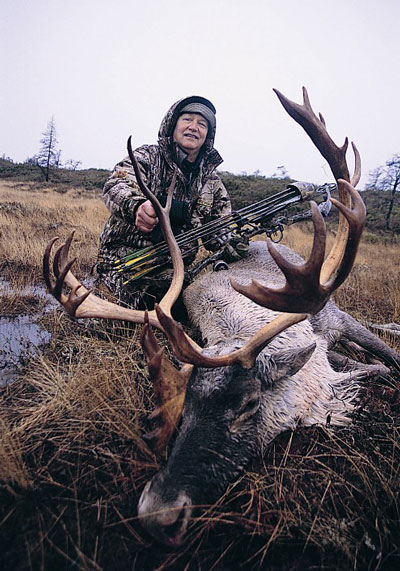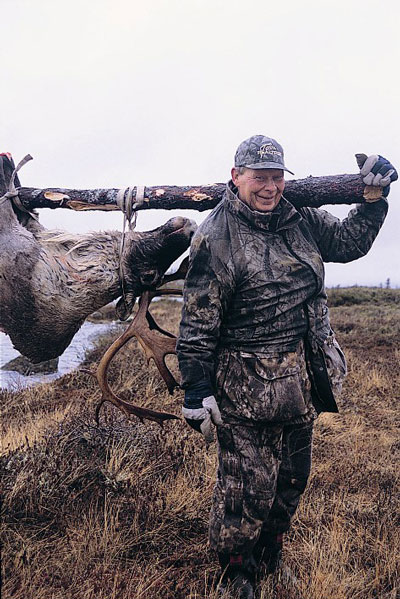 The majestic white mane and chocolate antlers of the woodland caribou make it one of North America’s top bowhunting trophies. Thriving in Newfoundland’s pristine wilderness of rolling tundra, bogs, and muskeg, hunters experience the rugged beauty of the North. Unfortunately in my case a hurricane stalled just off the coast, sending blankets of wind, rain, and soupy fog into our path. The elements raged for six consecutive days,
The majestic white mane and chocolate antlers of the woodland caribou make it one of North America’s top bowhunting trophies. Thriving in Newfoundland’s pristine wilderness of rolling tundra, bogs, and muskeg, hunters experience the rugged beauty of the North. Unfortunately in my case a hurricane stalled just off the coast, sending blankets of wind, rain, and soupy fog into our path. The elements raged for six consecutive days,
Our first look through binoculars showed a stream of caribou pouring down a distant ridge. As if late for an appointment, they headed in our direction—and fast. Moving with equal dispatch, we hustled along a game trail toward a midway ambush, setting up behind a huge boulder.
The band continued directly for us, prompting concern that my Newfoundland adventure would end practically before it began. Not to worry. The lead female moved into easy range, then stopped abruptly, raising her nose to the wind. Sensing something was wrong, she doubled back, leading the dozen or more followers away. The herd was upwind, yet our tracks left enough human odors to spook the wary female.
A Boyhood Dream Come True
As long as I can remember, the magnificent mount of a woodland caribou stag graced my grandfather’s dining room. The fleecy white main, wide chocolate-colored antlers, and majestic appearance enhanced Granddad’s stories of adventure in Newfoundland’s tundra wilderness. I was anxious to replicate my kin’s exploits and worked out the final arrangements with outfitter John Hicks for a post-rut adventure.
Barren ground, mountain, and Quebec/Labrador caribou are called “bulls” and “cows,” yet the woodlands are known as “stags” and “does.” Newfoundland’s caribou populations are booming, and the animals are widely dispersed through forests and open tundra, making them easy to locate and challenging to stalk. Just as important, Newfoundland’s hunting can be reached by ground and water transportation (ferry), eliminating restrictive airline weight limitations. Driving from the U.S. saves dramatically on airfare—you can take all the gear you want and bring your antlers and meat back home without extra duties. Finally, moose and bear make excellent combo situations if you want to bump up the adventure to safari-grade.
Tracking The Herd
Once the herd of caribou caught human scent, others quickly followed, and what seemed like a sure thing soon became a “learning experience.” We covered lots of ground this first day, hiking cross-country, fording streams, and doing our best to stay warm and dry. In late afternoon, we returned to the beginning point, a productive funnel of activity. An hour before dark, opportunity knocked as a dozen does approached along the same trail, followed by a handsome stag, its tall antlers in stark contrast to its snow-white main.
The herd emerged suddenly through a veil of steady wind and rain, such that I had to stalk the group from behind. The majestic stag offered a quartering-away shot at 60 yards, yet the difficult conditions and lengthy range relaxed my draw. Just like elk hunting in Montana, I’d circle ahead, wait by the trail, and get a closer shot—or so I thought. Attempting to travel from “here” to “there,” I soon became immersed in waist-deep water when a seemingly shallow puddle forgot to have a bottom. Small spruce trees were level on top, but the ground varied unpredictably with every step. What should have been 100 yards of quiet stealth turned into the tree and mud bog from Hell.
Hearing a whistle, I noticed my guide motioning up the hill. Watching the herd’s movements and my misadventures, he had a much better idea—use existing game trails. We glassed extensively, then tried several more ravines, but found nothing. How a dozen white animals could disappear in a sea of green amazed me.
See page 2 for more.
Early Bird Recordbook Stag
 Woodland caribou often bed until an hour or two after sunrise. Not taking any chances, I was back at the river crossing early the next morning, not a second too soon. Using the game trails, I soon came eyeball-to-eyeball with a herd of does. My proximity spooked the females, yet I saw a big stag lagging behind, grazing and not aware that his harem had been buggered. Crouching and running, I soon became amphibious again, rolling into deep water. Side stroking with bow and arrows raised like some new Olympic sport, I recovered with great skill, resumed the stalk, and closed ground on the stag.
Woodland caribou often bed until an hour or two after sunrise. Not taking any chances, I was back at the river crossing early the next morning, not a second too soon. Using the game trails, I soon came eyeball-to-eyeball with a herd of does. My proximity spooked the females, yet I saw a big stag lagging behind, grazing and not aware that his harem had been buggered. Crouching and running, I soon became amphibious again, rolling into deep water. Side stroking with bow and arrows raised like some new Olympic sport, I recovered with great skill, resumed the stalk, and closed ground on the stag.
As I peered over a boulder, the big male was still grazing, and I came to full draw as it caught my presence. The sight pin steadied in the wind and the arrow zipped away, quartering through the stag’s body. The bull trotted 50 yards, then went down.
“That’s a beauty,” said my guide as he approached. He had watched the stalk with binoculars from a nearby knoll. Although the stag had average top points, its bez tines were world-class. Two brow tines made it a double-shovel. All in all, it had 27 points, easily making the record book.






